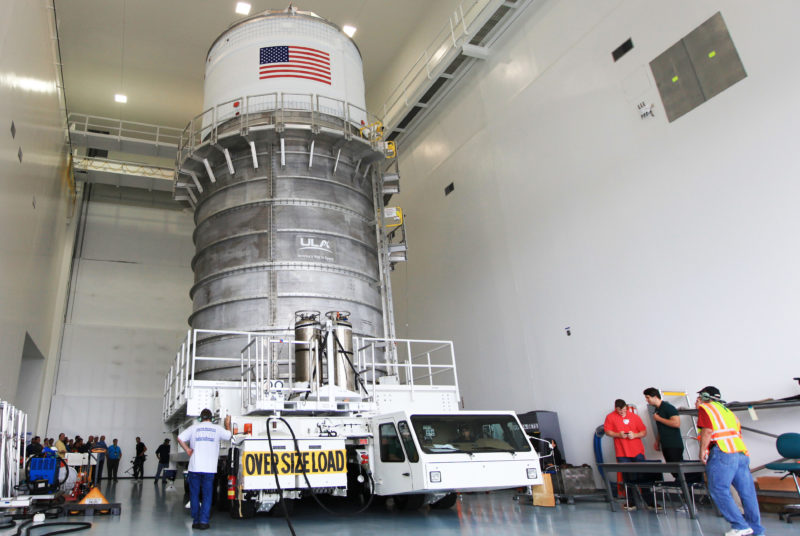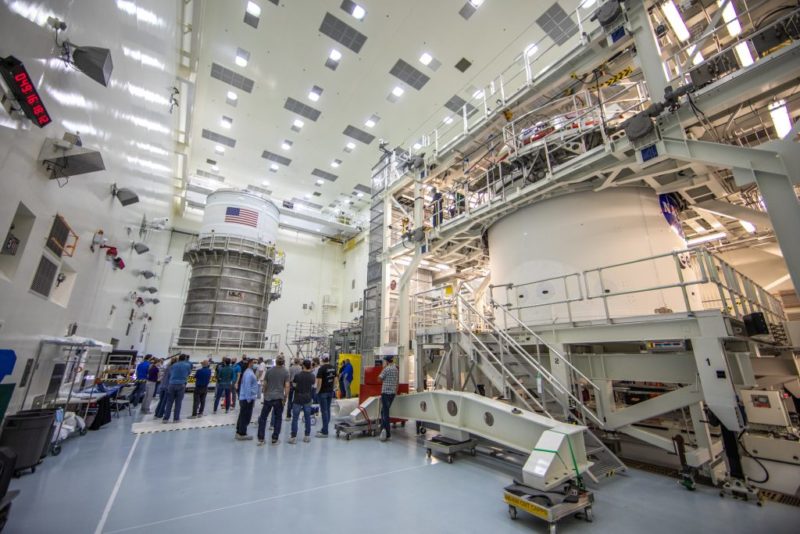
NASA’s first Space Launch System (SLS) gained an extra 10,000 pounds (4,500 kg) in weight earlier this week, when the Launch Vehicle Stage Adapter (LVSA)—a giant tapering cone which furnishes a structural link between the Core Stage and the Interim Cryogenic Propulsion Stage (iCPS)—was mounted atop the mammoth rocket. With the majority of the rocket now assembled inside High Bay 3 of the Vehicle Assembly Building (VAB) at the Kennedy Space Center (KSC) in Florida, hopes appear to be rekindled that the uncrewed Artemis-1 mission to the Moon may yet fly before year’s end.
Standing three stories tall, the LVSA was hoisted 250 feet (75 meters) above ground level and gently lowered into place atop the 212-foot-tall (64.6-meter) Core Stage, as more than a half of the first SLS is now structurally integrated. The LVSA departed NASA’s Marshall Space Flight Center (MSFC) in Huntsville, Ala., last 17 July—a day officially now known as “Artemis Day” in Alabama—and was arrived at KSC aboard the giant Pegasus barge to KSC on the 29th.
The initial five-year, $60 million contract to design, develop, test, evaluate and certify the LVSA was awarded by NASA to Teledyne Brown Engineering, Inc., of Huntsville, Ala., in early 2014. Under the terms of that contract, the firm partnered with MSFC to use its Advanced Welding Facility to build a Structural Test Article (STA) and two flight units of the adapter, with an option for a third flight unit.

It initially underwent processing in High Bay 4 of the VAB, ahead of integration earlier this week atop the remainder of the Artemis-1 stack.
Major welding on panels for the STA got underway in the late summer of 2015, with an innovative “friction-stir” process joining pieces together by “stirring” their edges without completely melting the metal. The result is a stronger weld than is achievable in standard welding practices.
Described by SLS Adapter Manager Brent Gaddes as presenting “challenges, due to its large size and conical shape”, the LVSA was fabricated using a wealth of expertise gained whilst building the stage adapter which linked an Orion spacecraft to the top of a United Launch Alliance (ULA) Delta IV Heavy rocket for the Exploration Flight Test (EFT)-1 mission in December 2014.
Following the completion of its eight vertical welds, the STA was lifted out of the welding machine and in June 2016 was confirmed structurally complete and ready for testing. It was moved to the 65-foot-tall (19.8-meter) test stand at MSFC in October 2016 in readiness for integrated “push, pull and twist” tests with test versions of the SLS core stage and other upper components of the rocket in early 2017.

That testing was conducted in tandem with duplicates of the SLS core stage, a frangible joint assembly, the ICPS, the Orion Stage Adapter (OSA) and Orion spacecraft, as well the LVSA STA, with around 50 test-cases conducted. To make the testing as realistic as possible, more than 500,000 pounds (227,000 kg) of axial hydraulic force and pressures as high as 56 psi (386 kPa) were applied to the test stack, with data gathered from over 1,900 instrumentation channels.
In the meantime, welding on the actual LVSA flight hardware for Artemis-1 got underway in the late summer of 2016. And it will certainly stand out when the complete SLS stack is fully integrated on the launch pad. During the course of the giant rocket’s Critical Design Review (CDR), it was reported that the LVSA element and the core stage would remain orange, the natural color of their Spray-On Foam Insulation (SOFI), rather than being painted white, as was originally intended.

“Because this section widens so much from top to bottom, it will experience extreme aerodynamic heating during launch,” NASA noted, “and the foam will protect the metal underneath from the high temperatures.” In August 2017, the LVSA was moved from the Advanced Weld Facility to the National Center for Advanced Manufacturing at MSFC for the lengthy SOFI process, applied by robotic and hand-held spray-guns.
By mid-2018, following the SOFI work, engineers began installing the LVSA’s separation systems and electronics and in March 2019 efforts to install the frangible joint assembly—a mechanism designed to break apart, thereby allowing hardware elements to properly separate in flight—got underway.

Following the LVSA’s arrival at KSC last summer, efforts to ready the first SLS entered high gear on several fronts. The twin five-segment Solid Rocket Boosters (SRBs) were delivered via rail last June to the Space Coast by prime contractor Northrop Grumman Corp., and were stacked in High Bay 3 of the VAB between last November and March of this year. And the Core Stage—powered by four shuttle-era RS-25 engines—completed a year-long “Green Run” test campaign at NASA’s Stennis Space Center (SSC) in Bay St. Louis, Miss., ahead of a full-flight-duration test-firing last March.
The Core Stage was delivered via Pegasus to KSC in late April and was lowered between the two SRBs on 12 June. With the integration of the LVSA, the stack currently stands more than 25 stories above ground level.

Next up—in what NASA describes as “challenging”—the Interim Cryogenic Propulsion Stage (iCPS), the Orion Stage Adapter (OSA) and the Orion spacecraft and Launch Abort System (LAS) will be installed, bringing the total height of the Artemis-1 SLS to some 322 feet (98 meters), taller than the Statue of Liberty.
For its part, the iCPS was the first integrated component of Artemis-1 to arrive at the Space Coast. Jointly developed by United Launch Alliance (ULA) and Boeing, it was delivered aboard ULA’s Mariner barge from Decatur, Ala., to Port Canaveral, in the spring of 2017.

After removal from its shipping container in the ULA Horizontal Integration Facility, the iCPS was moved to the Delta Operations Center and then to the Space Station Processing Facility. It was formally handed over to Ground Systems Development and Operations (GSDO) at KSC in November 2017.
More recently, last February the iCPS and the Orion spacecraft for Artemis-1 were transported to the Multi-Payload Processing Facility for fueling, which wrapped up in April. The two pieces of hardware then parted ways, with Orion headed for the Launch Abort System Facility for installation of its LAS and the iCPS bound for the VAB for storage, ahead of integration atop the SLS.

NASA remains committed to launching Artemis-1 from KSC’s landmark Pad 39B no sooner than November, although the space agency has previously acquiesced that this schedule will be “challenging”. Interestingly, this site’s first launch in May 1969 was Apollo 10, a full dress rehearsal in lunar orbit for the historic Apollo 11 landing on the surface of the Moon.
Pad 39B later saw four Saturn IB flights between May 1973 and July 1975, during the Skylab and Apollo-Soyuz Test Project (ASTP) era, then 53 shuttle launches between January 1986 and December 2006. Its most recent launch was the Ares I-X test flight under NASA’s ultimately-canceled Constellation Program in October 2009. As such, when Artemis-1 takes flight from Pad 39B, it will be the 60th launch from this historic complex.
FOLLOW AmericaSpace on Facebook and Twitter!
Missions » SLS » Artemis »





One Comment
One Ping
Pingback:‘Atlantis, Go’: Remembering the Shuttle’s Final Launch, Ten Years On